As advised by the LP I asked for a window on the right hand side (ask for the left hand side if coming from Chihuahua) to guarantee the best views.
The first hour and a bit of the ride, up to El Fuerte, allowed views into the back of several people´s houses with wild pigs, chickens and other animals all running around their backyards as the sun slowly rose.
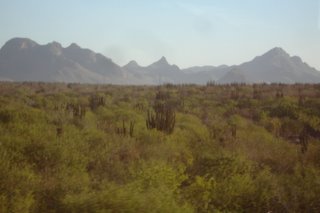 Then the first hint of the Barranca del Cobre (Copper Canyon) as mountains appeared on the horizon through a vista of catcus plants. The Ferrocaril Chihuahua al Pacifico boasts of being the world´s most scenic railway journey - and most of the other passengers sharing the first class train with me were late middle aged or retirees attracted by the promise as well as a scattering of local businessmen travelling north - most locals take the later second class train which runs slower and later. It´s half the price but it`s schedule means there`s the risk darkness will have fallen before you´ve experienced all the best views.
Then the first hint of the Barranca del Cobre (Copper Canyon) as mountains appeared on the horizon through a vista of catcus plants. The Ferrocaril Chihuahua al Pacifico boasts of being the world´s most scenic railway journey - and most of the other passengers sharing the first class train with me were late middle aged or retirees attracted by the promise as well as a scattering of local businessmen travelling north - most locals take the later second class train which runs slower and later. It´s half the price but it`s schedule means there`s the risk darkness will have fallen before you´ve experienced all the best views.About an hour beyond El Furte the scenery began living up to expectations,
 huge lakes, drops into deep valleys, waterfalls running down cliff-faces, river beds lined with boulders, then the train would thunder through a tunnel to reveal a new landscape beyond. Well maybe not thunder... the carriages are dragged along 655km of line by a self-powered engine, so perhaps chugged would be a better description.
huge lakes, drops into deep valleys, waterfalls running down cliff-faces, river beds lined with boulders, then the train would thunder through a tunnel to reveal a new landscape beyond. Well maybe not thunder... the carriages are dragged along 655km of line by a self-powered engine, so perhaps chugged would be a better description.The line opened in 1961 several decades after it had first been proposed and is one of the engineering marvels of the Latin American world. Freight trains also use the route but it`s tourists who help make the line ecomically viable - in peak season you need to book ahead to be certain of a seat - and it`s the same tourists´ pesos that have helped the several towns along the route grow in size over the past half a century.
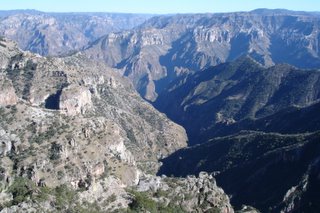 Although the views are inspiring, the best sight is at Divisidero where the train stops for 15 minutes to allow passengers to disembark and gape at the Barranca Del Cobre itself. 1879 metres deep with peaks 2300 metres above sea level it dwarfs the USA´s Grand Canyon. Copper plates and souvenirs are sold at street stalls by the sation, but the canyon doesn't derive its name from any seam of metal embedded in the rock, but rather from the colour it reflects in the late afternoon sun.
Although the views are inspiring, the best sight is at Divisidero where the train stops for 15 minutes to allow passengers to disembark and gape at the Barranca Del Cobre itself. 1879 metres deep with peaks 2300 metres above sea level it dwarfs the USA´s Grand Canyon. Copper plates and souvenirs are sold at street stalls by the sation, but the canyon doesn't derive its name from any seam of metal embedded in the rock, but rather from the colour it reflects in the late afternoon sun.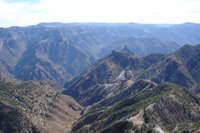 The eye doesn´t know where to look - skipping from peak to peak, from valley to tree lined cliff-face (the photo on the left and the one above only show only a small part of the view - you´d need to stick several pictures together to get an idea of the panorama´s width). The vegetation is all the more impressive as it grows right out of the rock - geologists believe it gives us a hint of what the American Canyon will look like several thousand years from now once it has caught up. As I´d later see the trees are widening several of the valleys - their roots slowly breaking up the rock which splinters sending boulders crashing down to the valley floor, while seeds fall into the newly produced cracks allowing the process to repeat itself.
The eye doesn´t know where to look - skipping from peak to peak, from valley to tree lined cliff-face (the photo on the left and the one above only show only a small part of the view - you´d need to stick several pictures together to get an idea of the panorama´s width). The vegetation is all the more impressive as it grows right out of the rock - geologists believe it gives us a hint of what the American Canyon will look like several thousand years from now once it has caught up. As I´d later see the trees are widening several of the valleys - their roots slowly breaking up the rock which splinters sending boulders crashing down to the valley floor, while seeds fall into the newly produced cracks allowing the process to repeat itself. The minutes shot by before the train`s whistle warned it was about to leave. It would be all to easy to get left behind, tempted by one more picture. The a further hour and a half journey to Creel. By this point we´d experienced most of the best views as pine tress obscure further sightlines into the canyon´s depths, although there are fleeting glimspes.
The minutes shot by before the train`s whistle warned it was about to leave. It would be all to easy to get left behind, tempted by one more picture. The a further hour and a half journey to Creel. By this point we´d experienced most of the best views as pine tress obscure further sightlines into the canyon´s depths, although there are fleeting glimspes.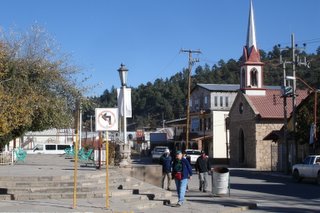 I got off at Creel station, just over half way along the route. It´s a small town with almost all the activity taking place on two roads running either side of the railway line. After hunking my ever heavier luggage onto the platform I was swarmed by a bunch of kids shouting out `Magarita´ - the name of the hostel I`d booked a place at, so I followed them and boarded an ancient bus. The driver must have been about 10 years old and offered me and the other passengers the choice of 2 places to stay - the ramshackle, but fun, Casa Magarita or the more upmarket Hotel Magarita´s Plaza Magarita. An American couple in their 50´s were bewildered by the kids´ Spanish chatter so I translated for them explaining the choice between the two. On discovering I was from Scotland the American woman complimented me for the quality of my English. Scary.
I got off at Creel station, just over half way along the route. It´s a small town with almost all the activity taking place on two roads running either side of the railway line. After hunking my ever heavier luggage onto the platform I was swarmed by a bunch of kids shouting out `Magarita´ - the name of the hostel I`d booked a place at, so I followed them and boarded an ancient bus. The driver must have been about 10 years old and offered me and the other passengers the choice of 2 places to stay - the ramshackle, but fun, Casa Magarita or the more upmarket Hotel Magarita´s Plaza Magarita. An American couple in their 50´s were bewildered by the kids´ Spanish chatter so I translated for them explaining the choice between the two. On discovering I was from Scotland the American woman complimented me for the quality of my English. Scary.They decided to go for the more upmarket option while I stayed on board for the Casa - which turned out to be metres from where they`d first picked me up! All the same the chance to be hurtled around town by a driver not old enough to shave is worth the experience.
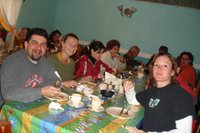 The hostel itself is a higgledy-piggledy assortment of building containing ´cosy´ but comfortable double-bedded rooms as well as a dorm. A private room is about 300 pesos which is a bargain as it includes breakfast and dinner. The food isn´t gourmet and included heinz spaghetti and green stuff on tacos for dinner and a suprisingly tasty white gloop with fruit as part of a huge hearty breakfast. But the huge bonus is that everyone eats together at the same time meaning it`s a fantasticly easy place to meet other travellers, and sign up together for one of the assortment of tours offered by the hostel. And - as we did on my first night - go drinking together.
The hostel itself is a higgledy-piggledy assortment of building containing ´cosy´ but comfortable double-bedded rooms as well as a dorm. A private room is about 300 pesos which is a bargain as it includes breakfast and dinner. The food isn´t gourmet and included heinz spaghetti and green stuff on tacos for dinner and a suprisingly tasty white gloop with fruit as part of a huge hearty breakfast. But the huge bonus is that everyone eats together at the same time meaning it`s a fantasticly easy place to meet other travellers, and sign up together for one of the assortment of tours offered by the hostel. And - as we did on my first night - go drinking together.I´d arrived in the quiet period, and although Casa Magarita was busy many of the other hotels were empty. A couple of girls I met the next day had resisted the boys shouts and checked in elsewhere only to find they were the only guests - and ended up coming round to Magarita´s in the evening to book tours and meet the rest of us. Another side effect of low season was that all the bars were closed the first evening with the exception of the Best Western Hotel´s which was hosting a party for a group from Mexico City. We gatecrashed the event, were offered shots of tequila and sipped some of the country´s most expensive beers as the Mexicans sang folk songs and increasingly slurred voices.
 I´d signed up for a visit to the Hot Springs the following morning. My fellow travellers were a retired couple from France, and two French girls in their late 20´s who I mentiuoned in the previous paragraph. Communication with the elder pair was a mixture of my terrible schoolboy French and their only slightly more impressive English.
I´d signed up for a visit to the Hot Springs the following morning. My fellow travellers were a retired couple from France, and two French girls in their late 20´s who I mentiuoned in the previous paragraph. Communication with the elder pair was a mixture of my terrible schoolboy French and their only slightly more impressive English. Despite this we managed several basic conversations in between his copious photo taking. I swear he must have a photo of just about every
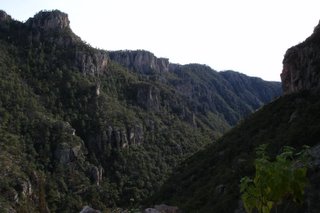 possible bit of scenery from the day. He filled a 1GB memory card, swapped it for another and continued snapping away. They had come over to Mexico after their son married a Mexican girl and were now enjoying a 2 month trip of a lifetime - and obviously not wanting to forget a single sight.
possible bit of scenery from the day. He filled a 1GB memory card, swapped it for another and continued snapping away. They had come over to Mexico after their son married a Mexican girl and were now enjoying a 2 month trip of a lifetime - and obviously not wanting to forget a single sight. To get to the springs we were driven about 45mins out of town into the forest and partway down a thin rough path. Then the `tour-guide´ announced it was time for us to hike the rest of the journey while he took a 4 hour nap. The walk down to the valley floor allowed some spectacular views of the cliff faces above and the temperature began to noticeably rise as we made the steep descent.
To get to the springs we were driven about 45mins out of town into the forest and partway down a thin rough path. Then the `tour-guide´ announced it was time for us to hike the rest of the journey while he took a 4 hour nap. The walk down to the valley floor allowed some spectacular views of the cliff faces above and the temperature began to noticeably rise as we made the steep descent. Then we followed the a slow moving river round several more bends until we finally got our first glimpse of the springs themselves. I was expecting a natural pool, like the ones I´d visited in Chiapas, but in fact the waters were collected in man made basins just above the valley floor. The warm water originates higher up the rockface and runs down the rocks into the first of a series of interconnected pools, each bigger than the other.
Then we followed the a slow moving river round several more bends until we finally got our first glimpse of the springs themselves. I was expecting a natural pool, like the ones I´d visited in Chiapas, but in fact the waters were collected in man made basins just above the valley floor. The warm water originates higher up the rockface and runs down the rocks into the first of a series of interconnected pools, each bigger than the other. This meant a dip in the smaller pools allowed us to experience the warm water as it crashed off the rocks onto our backs providing a massage as if from a supercharged shower, while the bigger pools, which were large enough to swim in, offered the contrast of a more chilly invigorating experience.
This meant a dip in the smaller pools allowed us to experience the warm water as it crashed off the rocks onto our backs providing a massage as if from a supercharged shower, while the bigger pools, which were large enough to swim in, offered the contrast of a more chilly invigorating experience.We stayed at the bottom a couple of hours, sunbathing, swimming and generally chilling out before a strenous hike back up to our dozing driver.
 At the hostel I met a Dutch artist I´d chatted to the night before and we went to the now open Tio Molcas bar to begin a notable drinking Tequila and cerveza session which was only temporarily interrupted by dinner back at the hostel. We were joined at times by a very cool married couple from Canada (also seen in the above pic) who had driven an RV down to Mexico, a younger American pair of teachers from the US, a 20-something Belgian translator who´d left her job to travel Latin America alone, the French girls and the Mexican barkeeper.
At the hostel I met a Dutch artist I´d chatted to the night before and we went to the now open Tio Molcas bar to begin a notable drinking Tequila and cerveza session which was only temporarily interrupted by dinner back at the hostel. We were joined at times by a very cool married couple from Canada (also seen in the above pic) who had driven an RV down to Mexico, a younger American pair of teachers from the US, a 20-something Belgian translator who´d left her job to travel Latin America alone, the French girls and the Mexican barkeeper.  I decided that I´d travel onto Chihuahua by bus the following day instead of by train as it would give me more time in Creel and the chance to go on a second tour - this time to visit several of the surrounding Canyons. Although the area is known as the Copper Canyon there are in fact more than 20. As we enjoyed the vertigo inducing views our guide informed us that much of the surrounding area is inhabited by the Tarahumara tribe - many of whom have never travelled to the towns or villages and live in log cabins or in some case caves. Like many of Mexico´s other indigenous tribes, the 50,000 Tarahumarans wear incredibly bright clothes which presumably make them easier to see at night far from the nearest electrical lamp ;)
I decided that I´d travel onto Chihuahua by bus the following day instead of by train as it would give me more time in Creel and the chance to go on a second tour - this time to visit several of the surrounding Canyons. Although the area is known as the Copper Canyon there are in fact more than 20. As we enjoyed the vertigo inducing views our guide informed us that much of the surrounding area is inhabited by the Tarahumara tribe - many of whom have never travelled to the towns or villages and live in log cabins or in some case caves. Like many of Mexico´s other indigenous tribes, the 50,000 Tarahumarans wear incredibly bright clothes which presumably make them easier to see at night far from the nearest electrical lamp ;)The tribe is perhaps most famous for its long distance runners. They developed the skill to help them hunt deer, exhausting them with long chases before driving them over cliffs. In 1993 they came to the attention of an American entrepeneur who entered them into the Colorado 100 mile ultramarathon. Victoriano Churra, one of the tribesmen, easily won the competition running the distance without rest with little preparation. He´s gone on to win several other American competitions.
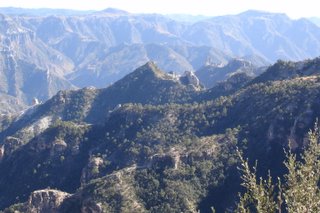 The tour also took in a winding road across a cleared area - it had been a landing strip for tourist planes but was abandoned after the authorities discovered drug smugglers were also making use of it at night. Then finally we were driven to the main Copper Canyon again where we saw very shaky looking ladders the Tarahumara use to scale up and down the rockface - it takes them 2hrs to get from the top to the bottom - there was no way I was even going to hang over the edge to reach he first rung.
The tour also took in a winding road across a cleared area - it had been a landing strip for tourist planes but was abandoned after the authorities discovered drug smugglers were also making use of it at night. Then finally we were driven to the main Copper Canyon again where we saw very shaky looking ladders the Tarahumara use to scale up and down the rockface - it takes them 2hrs to get from the top to the bottom - there was no way I was even going to hang over the edge to reach he first rung.  Ted, the Canadian husband ventured out onto the `floating rock´ to balance precariously above the huge drop to the disbelief of his wife before they bought several baskets the Tarahumara intricately weave out of grass and sell for a couple of pesos. The wife crammed so many in her bag that they´ll probably be flattened into table coasters by the time she gets home.
Ted, the Canadian husband ventured out onto the `floating rock´ to balance precariously above the huge drop to the disbelief of his wife before they bought several baskets the Tarahumara intricately weave out of grass and sell for a couple of pesos. The wife crammed so many in her bag that they´ll probably be flattened into table coasters by the time she gets home.Then time to say goodbye to another group of friends and board the bus for a 22 hour bus journey to Zacatecas via Chihuahua...
2 comments:
Hey, Leo,
Great site, and thanks for calling us that "cool" couple from Canada. Lesley would hug you to death if she could get her hands on you (so you know what to expect when you get to Vancouver).
My only wish is that you had taken my picture while I was standing (sort of) on the floating rock instead of cowering on my hands. We Canadians have a lot to prove, you know.
We got home last night after about 1000km of driving from northern California to Vancouver. Snow in the pass held us up in Redding California for a night, but it was clear by the morning so we just ran for home. The baskets made it back intact, so we will have to shop separately for coasters!
I'll check in once in awhile. Keep on trekking!
Regards, Ted.
Whatever you do, do not travel by viva aereobus ,
they ruined my trip, I went to Chiuhuahua, I made the same expedition, but viva aereobus, ruined it. .I was about to leave chihuahua to visit monterey, the plane never arrived, they stole my money, it sucks"!!!!!!!!!!!!!!!!
Post a Comment